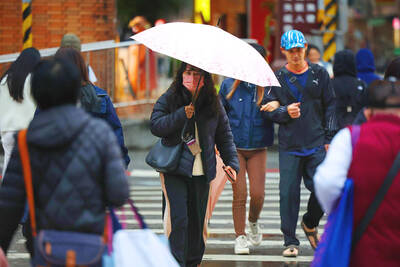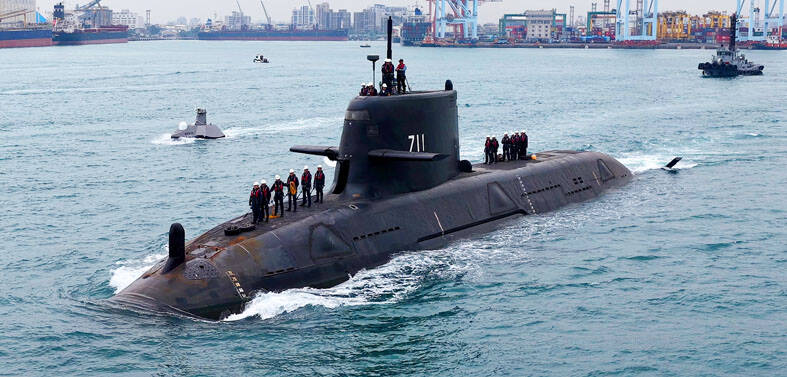The Canadian government on Tuesday confirmed that a Royal Canadian Navy ship had sailed through the Taiwan Strait, three months after a similar operation and amid strained ties between Beijing and Ottawa.
Beijing in April condemned a French decision to send a frigate through the Strait as illegal, and has also been upset by US Navy ships passing through the same waterway.
Canada’s government said that the frigate HMCS Ottawa passed through the Strait on Monday and Tuesday.
“This route was chosen as it was the most direct route between UN Security Council sanctions monitoring activities in Northeast Asia and engagements in Southeast Asia,” the Canadian Department of National Defence said on Tuesday.
“The Royal Canadian Navy does not conduct so-called ‘freedom of navigation’ operations aimed at challenging the territorial claims of other nations, and the ship’s transit was conducted in accordance with international law, including the United Nations Convention on the Law of the Sea,” it added.
In June, two Canadian ships sailed through the Strait, but the government denied it was trying to make any kind of political point.
The Ministry of National Defense on Tuesday said that the latest ship passed through the Strait in a southerly direction and was monitored throughout by the armed forces.
Chinese Ministry of Foreign Affairs spokeswoman Hua Chunying (華春瑩) yesterday said that China does not take exception to “normal passage” through the Strait by foreign warships.
“But I don’t know what special purpose the Canadian side had in taking pains to make such a high-profile announcement about this,” she told a daily news briefing. “We hope the Canadian side takes practical actions to show that it respects China’s sovereignty and security.”
Canada-China relations have nosedived in the past year.
China, furious that Canadian police arrested a senior Huawei Technologies Co executive on Dec. 1 last year on a US warrant, has blocked imports of meat products and canola seed from Canada and charged two Canadian men with spying.
However, both nations last week appointed new ambassadors to each other’s capitals, in a sign that ties might be thawing.

NUMBERS IMBALANCE: More than 4 million Taiwanese have visited China this year, while only about half a million Chinese have visited here Beijing has yet to respond to Taiwan’s requests for negotiation over matters related to the recovery of cross-strait tourism, the Tourism Administration said yesterday. Taiwan’s tourism authority issued the statement after Chinese-language daily the China Times reported yesterday that the government’s policy of banning group tours to China does not stop Taiwanese from visiting the country. As of October, more than 4.2 million had traveled to China this year, exceeding last year. Beijing estimated the number of Taiwanese tourists in China could reach 4.5 million this year. By contrast, only 500,000 Chinese tourists are expected in Taiwan, the report said. The report

Temperatures are forecast to drop steadily as a continental cold air mass moves across Taiwan, with some areas also likely to see heavy rainfall, the Central Weather Administration (CWA) said. From today through early tomorrow, a cold air mass would keep temperatures low across central and northern Taiwan, and the eastern half of Taiwan proper, with isolated brief showers forecast along Keelung’s north coast, Taipei and New Taipei City’s mountainous areas and eastern Taiwan, it said. Lows of 11°C to 15°C are forecast in central and northern Taiwan, Yilan County, and the outlying Kinmen and Lienchiang (Matsu) counties, and 14°C to 17°C

SHIPS, TRAINS AND AUTOMOBILES: The ministry has announced changes to varied transportation industries taking effect soon, with a number of effects for passengers Beginning next month, the post office is canceling signature upon delivery and written inquiry services for international registered small packets in accordance with the new policy of the Universal Postal Union, the Ministry of Transportation and Communications said yesterday. The new policy does not apply to packets that are to be delivered to China, the ministry said. Senders of international registered small packets would receive a NT$10 rebate on postage if the packets are sent from Jan. 1 to March 31, it added. The ministry said that three other policies are also scheduled to take effect next month. International cruise ship operators

STEERING FAILURE: The first boat of its class is experiencing teething issues as it readies for acceptance by the navy, according to a recent story about rudder failure The Hai Kun (海鯤), the nation’s first locally built submarine, allegedly suffered a total failure of stern hydraulic systems during the second round of sea acceptance trials on June 26, and sailors were forced to manually operate the X-rudder to turn the submarine and return to port, news Web site Mirror Daily reported yesterday. The report said that tugboats following the Hai Kun assisted the submarine in avoiding collisions with other ships due to the X-rudder malfunctioning. At the time of the report, the submarine had completed its trials and was scheduled to begin diving and surfacing tests in shallow areas. The X-rudder,